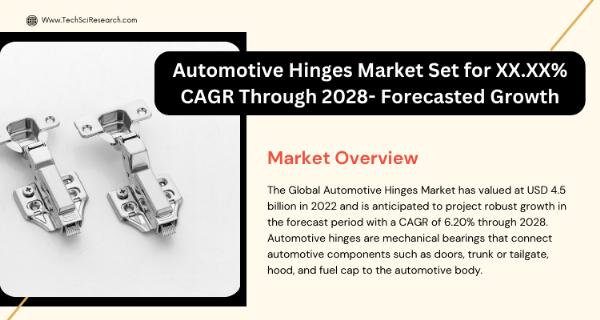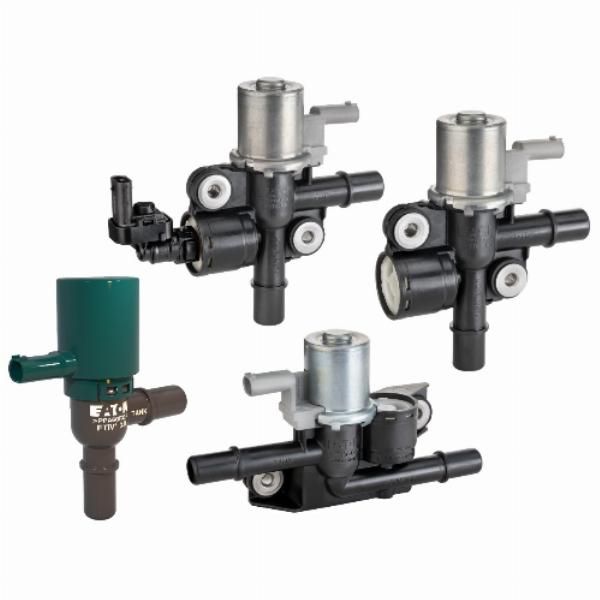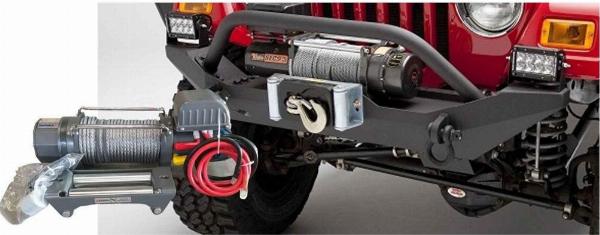Automotive Hinges Market - Rising Demand and Growth Trends

Strong 8k brings an ultra-HD IPTV experience to your living room and your pocket.
According to TechSci Research report, “Automotive Hinges Market – Global Industry Size, Share, Trends, Competition Forecast & Opportunities, 2028”, the Global Automotive Hinges Market stood at USD 4.5 Billion in 2022 and is anticipated to grow with a CAGR of 6.20% in the forecast period, 2024-2028. Automotive hinges are mechanical bearings that connect automotive components such as doors, trunk or tailgate, hood, and fuel cap to the automotive body.
The automotive hinges allow a door or hood to open at a certain angle between the automotive body and the door or hood. The two automotive components connected by the automotive hinges revolve relatively to each other around a fixed axis of rotation.
The material used in automotive hinges depends upon its end-use as the doors, hood, and tailgate require steel or any heavy material, but the fuel cap does not require a heavy or robust material. The doors of premium and sports cars are automatically opened by electronic-operated automotive hinges.
Browse over market data Figures spread through 180 Pages and an in-depth TOC on " Global Automotive Hinges Market.” @ https://www.techsciresearch.com/report/automotive-hinges-market/21062.html
The global automotive hinges market, a critical facet of the automotive industry, is witnessing a transformative phase shaped by a confluence of technological advancements, market dynamics, and evolving consumer preferences. Hinges, often perceived as inconspicuous components, play a pivotal role in the functionality, safety, and design of vehicles. As the automotive landscape undergoes unprecedented changes, the automotive hinges market is propelled by a multitude of factors, each contributing to its intricate tapestry.
One of the primary drivers propelling the global automotive hinges market into new frontiers is the continuous wave of technological advancements in materials and manufacturing processes. Traditionally composed of robust steel, automotive hinges are now experiencing a paradigm shift towards advanced materials like aluminum alloys, high-strength composites, and lightweight alloys. This shift is not merely driven by a quest for novelty but by a fundamental need to align with the overarching trend of lightweighting within the automotive industry.
As the demand for fuel-efficient and eco-friendly vehicles intensifies, hinges must now embody a delicate balance of strength, durability, and reduced weight. Precision manufacturing processes, facilitated by technologies like computer-aided design (CAD) and finite element analysis (FEA), are optimizing hinge designs for structural integrity, meeting the demands of modern vehicle architectures.
Rising vehicle production and sales globally constitute another potent force steering the automotive hinges market. The automotive industry's expansion, propelled by factors such as increasing urbanization, population growth, and rising consumer disposable income, directly influences the demand for automotive hinges. As more vehicles roll off production lines, the need for hinges for doors, trunks, and hoods escalates proportionally. This trend is further amplified by the globalization of automotive production, as emerging markets in regions like Asia-Pacific, Latin America, and Africa become key players in the automotive manufacturing landscape. The growing affluence of consumers globally contributes to heightened vehicle ownership, further boosting the demand for automotive hinges. For hinge manufacturers to leverage this driver effectively, an in-depth understanding of regional market dynamics, strategic partnerships with automotive OEMs, and scalable production capacities are imperative.
The increasing emphasis on vehicle safety and crashworthiness emerges as a compelling driver that shapes the trajectory of the global automotive hinges market. Regulatory bodies worldwide are elevating safety standards, demanding rigorous crash testing to ensure the structural integrity of vehicles during collisions. Automotive hinges, being integral components in the assembly of doors and other moving parts, play a pivotal role in meeting these stringent safety requirements.
Beyond regulatory compliance, consumer demand for advanced safety features is influencing the evolution of automotive hinges. The integration of technologies such as side-impact airbags, pedestrian protection systems, and automatic door closing mechanisms necessitates hinges that can seamlessly accommodate these features. Hinge manufacturers, therefore, find themselves at the intersection of safety compliance and the implementation of cutting-edge safety technologies, requiring ongoing research and development efforts and close collaboration with automotive OEMs.
Innovation in vehicle design and architecture emerges as a dynamic force propelling the global automotive hinges market forward. The automotive industry is witnessing a fundamental transformation as electric vehicles (EVs) and autonomous vehicles become more prevalent. Electric vehicles, with their unique powertrain layouts and weight distribution, demand hinges that can adapt to these design changes.
Furthermore, the integration of sensors and advanced electronics in autonomous vehicles necessitates hinges that can support the seamless incorporation of these technologies. As the industry places an increasing emphasis on lightweighting to enhance fuel efficiency and reduce emissions, hinges must align with lightweight design principles. Innovations such as concealed or hidden hinge designs not only contribute to improved aerodynamics but also reflect the evolving aesthetic preferences in modern vehicle architectures. To harness the opportunities presented by innovation in vehicle design, hinge manufacturers must foster close collaboration with automotive designers, OEMs, and other stakeholders, remaining agile and adaptive to emerging trends.
Sustainability considerations emerge as a key driver influencing the global automotive hinges market. The automotive industry, like many others, is undergoing a paradigm shift towards sustainability and environmental responsibility. This shift is compelling hinge manufacturers to explore eco-friendly materials, sustainable manufacturing processes, and end-of-life considerations. Recycled materials, such as recycled aluminum, are gaining traction in hinge construction, aligning with the principles of a circular economy. The exploration of bio-based materials further reduces the environmental footprint of hinge manufacturing.
Moreover, sustainable manufacturing processes, characterized by energy-efficient technologies and waste reduction initiatives, are becoming integral to hinge production. As the industry pivots towards sustainability, hinge manufacturers must position themselves as contributors to broader environmental goals, engaging in research and development to identify eco-friendly materials, collaborating with material suppliers, and actively participating in industry initiatives for sustainable manufacturing practices.
Major companies operating in the Global Automotive Hinges Market are:
- Brano Group
- Eberhard Manufacturing Company
- Gaoming Ligang Precision Casting Co., Ltd
- Tenneco Inc
- Wenzhou Rongan Auto Parts Co., Ltd
- Magna International Inc.
- Aisin Seiki Co. Ltd
- Scissor Doors Inc.
- Gestamp Group
- Global Rollforming System LLC
Download Free Sample Report @ https://www.techsciresearch.com/sample-report.aspx?cid=21062
Customers can also request 10% free customization in this report.
“The global automotive hinges market is a dynamic sector propelled by technological advancements, increasing vehicle production, safety imperatives, design innovations, and sustainability considerations. As vehicles evolve with electric and autonomous technologies, hinges play a crucial role in adapting to shifting design requirements. Technological innovations in materials and manufacturing processes, coupled with a rising emphasis on lightweighting, are reshaping hinge construction. Moreover, stringent safety standards and the integration of advanced safety features drive continuous advancements in hinge technologies. Sustainability considerations further influence the market, pushing manufacturers towards eco-friendly materials and sustainable practices. In essence, the global automotive hinges market stands at the intersection of innovation, safety, and environmental responsibility, driving the evolution of vehicles worldwide,” said Mr. Karan Chichi, Research Director with TechSci Research, a research-based management consulting firm.
“Automotive Hinges Market– Global Industry Size, Share, Trends, Opportunity, and Forecast, Segmented By Vehicle Type (Passenger cars, LCV, HCV), By Product Type (Door, Cabinet, Hood, Others), By Sales Channel (OEM, Aftermarket), By Region, Competition, 2018-2028”, has evaluated the future growth potential of Global Automotive Hinges Market and provides statistics & information on market size, structure, and future market growth. The report intends to provide cutting-edge market intelligence and help decision makers take sound investment decisions. Besides, the report also identifies and analyzes the emerging trends along with essential drivers, challenges, and opportunities in the Global Automotive Hinges Market.
You may also read:
Automotive Radiator Fan Market [Latest] Unveiling Growth Opportunities, and Trends
Fuel Cell Powertrain Market Detailed Analysis of Share, Growth [2028]
Truck Trailer Landing Gear Market on the Rise [2028]- Driving Growth
Bike Sharing Market Trends [2028]- Exploring the Dynamics of Industry
Automotive Throttle Cables Market [2028] Analysis, Trends, and Key Players.
Table of Content-Automotive Hinges Market
- Introduction
1.1. Product Overview
1.2. Key Highlights of the Report
1.3. Market Coverage
1.4. Market Segments Covered
1.5. Research Tenure Considered
- Research Methodology
2.1. Objective of theStudy
2.2. Baseline Methodology
2.3. Key Industry Partners
2.4. Major Association and Secondary Sources
2.5. Forecasting Methodology
2.6. Data Triangulation & Validation
2.7. Assumptions and Limitations
- Executive Summary
3.1. Market Overview
3.2. Market Forecast
3.3. Key Regions
3.4. Key Segments
- Impact of COVID-19 on Global Automotive Hinges Market
- Global Automotive Hinges Market Outlook
5.1. Market Size & Forecast
5.1.1. By Value
5.2. Market Share & Forecast
5.2.1. By Vehicle Type Market Share Analysis (Passenger cars, LCV, HCV)
5.2.2. By Product Type Market Share Analysis (Door, Cabinet, Hood, Others)
5.2.3. By Sales Channel Market Share Analysis (OEM, Aftermarket)
5.2.4. By Regional Market Share Analysis
5.2.4.1. Asia-Pacific Market Share Analysis
5.2.4.2. Europe & CIS Market Share Analysis
5.2.4.3. North America Market Share Analysis
5.2.4.4. South America Market Share Analysis
5.2.4.5. Middle East & Africa Market Share Analysis
5.2.5. By Company Market Share Analysis (Top 5 Companies, Others - By Value, 2022)
5.3. Global Automotive Hinges Market Mapping & Opportunity Assessment
5.3.1. By Vehicle Type Market Mapping & Opportunity Assessment
5.3.2. By Product Type Market Mapping & Opportunity Assessment
5.3.3. By Sales Channel Market Mapping & Opportunity Assessment
5.3.4. By Regional Market Mapping & Opportunity Assessment
- Asia-Pacific Automotive Hinges Market Outlook
6.1. Market Size & Forecast
6.1.1. By Value
6.2. Market Share & Forecast
6.2.1. By Vehicle Type Market Share Analysis
6.2.2. By Product Type Market Share Analysis
6.2.3. By Sales Channel Market Share Analysis
6.2.4. By Country Market Share Analysis
6.2.4.1. China Market Share Analysis
6.2.4.2. India Market Share Analysis
6.2.4.3. Japan Market Share Analysis
6.2.4.4. Indonesia Market Share Analysis
6.2.4.5. Thailand Market Share Analysis
6.2.4.6. South Korea Market Share Analysis
6.2.4.7. Australia Market Share Analysis
6.2.4.8. Rest of Asia-Pacific Market Share Analysis
Note: IndiBlogHub features both user-submitted and editorial content. We do not verify third-party contributions. Read our Disclaimer and Privacy Policyfor details.







